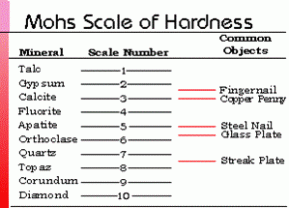How Do I Know What Hard Surface Floor I Will Be Cleaning? – Floor Identification Series – Part 6 of 7 – Hardness Scratch Test
Testing Procedures for Floor Identification:
There are actually six different “tests” or evaluations you can perform to zero in on the type of floor you are being asked to clean. This post is going to focus on the 5th test or evaluation – the Moh’s Hardness Test, sometimes called the scratch test.
5. The Scratch (or Hardness) Test. The scratch test for stone is based on a scale developed by Friedrich Moh in 1822. It
 measures the relative hardness of natural stone
measures the relative hardness of natural stone- It is ranked on 10 steps. There is great variation in the “steps.
- Essentially, you are determining what scratches what.
- Here are some ratings of some common materials
- 2.5 – Fingernail
- 2.5-5 – Marble (most is 3 – 4.5)
- 2.5-5 – Limestone (most is under 4 but some limestone is harder.)
- 5.5 – Steel knife or nail
- 7 and above – Glazed ceramic or porcelain
- 7-8 – Granite
Choose your tool to scratch with
- Quartz = 7
- Steel nail = 5.5
- Fingernail = 2.5
Try to scratch the stone with a sharp corner of your tool
- Do the reverse – Try to scratch your tool with the stone
- By determining “What scratches what” or “What is equal“ you can make judgments about hardness
- If a floor is hard and difficult to scratch, it is probably a man-made ceramic or porcelain tile.
- The exception is granite, which is natural, but is difficult to scratch
- Softer stone such as travertine, marble, limestone, and slate will all scratch to differing degrees with this test procedure.
- If a floor is hard and difficult to scratch, it is probably a man-made ceramic or porcelain tile.
- 4. 5.5 is an important dividing line. Every stone below 5.5 will show scratches. Every stone above 5.5 like granite and quartz will not. That is why they use granite for kitchen
 countertops.
countertops.
Cleaning application – on softer stone, precautions must be taken to not scratch the surface of the floor when using a rotary extraction tool. If the floor did scratch when tested or has an epoxy urethane finish that will scratch, use the brush ring on your rotary extraction tool.
Tags: cleaning, hardness test, identification, scratch test





